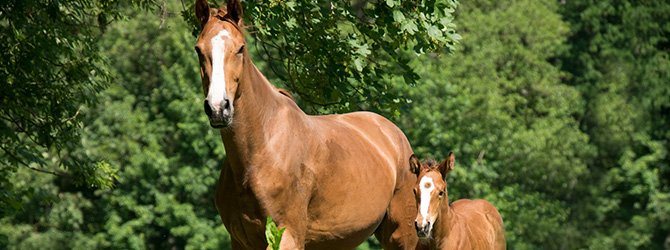Mare and foal: guide to mare foaling at home
Mare foaling at home can be a joyous experience, if you’re prepared for it.
As prey animals, horses show very few outward signs of illness or disease.
This means that once a foal has been born, you’ll need to pay close attention, especially during their first 24 hours.
After the foal has been delivered
After the birth, try to keep intervention to a minimum. This will make sure you don’t compromise the mare-foal bond. You may find that the mare is lying down after delivery, and that the foal’s legs remain inside her for a few minutes.
When either the mare or foal moves, the umbilical cord will break at its weakest point – never cut/clamp it. The piece of umbilical cord attached to the foal should be bathed in a 0.5% chlorhexidine/iodine and alcohol solution. Repeat this process for a few days until it’s dry.
When should a foal first stand up?
Typically, a new foal should be able to stand up within 2 hours of birth.
If the mare remains laid down, move the foal to her head so she can bond with them. She may lick their head and at this point, you should find that the foal can support themselves on their chest. They’ll soon attempt to stand up, and should be successful after a few attempts.
When should they first suck?
You should find that the foal is quick to search for milk as soon as they stand up for the first time. It may take several attempts for them to feed successfully – you may need to guide them, or to encourage the mare to stand still.
If the foal doesn’t feed within 4 hours of birth, contact your equine vet as soon as possible. Failure to feed in these initial hours can lead to health problems.

Caring for a newly born foal
The new foal will be given a tetanus anti-toxin injection to protect them for the initial months. This will need to be followed up with a vaccination to ensure continuity of care. Your equine vet will be able to advise further.
Feeding and toileting:
Most foals will feed up to 7 times an hour whilst they’re awake. Typically, they’ll gain 2kg of bodyweight per day during their first week.
You may find that the foal’s first faeces is very dark and firm – this is known as meconium. As the foal continues to feed, their faeces should become gradually softer. The foal should urinate within 8 hours of birth. If you’re concerned about their ability to pass faeces, contact your equine vet right away.
Foal behaviour
You should find the foal to be very curious; they’ll interact freely with their mother and with humans. Contact your equine vet if this doesn’t seem to be the case. It’s also a good idea to call your vet if you notice any of these characteristics:
- A domed forehead
- A low bodyweight
- Weakness
- Deformed limbs
- A silky coat
- Floppy ears
The foal’s first vet check
Even if everything seems fine, it’s a good idea to have the new foal and their mother checked by a vet – ideally within 12-24 hours of birth.
The vet will check:
- That the mare has enough milk
- That the mare hasn’t been injured during delivery
- That the entire placenta has been passed (you’ll need to keep it in a bucket)
And of course… that the foal is in good health! This will include checking their eyes, heart, lungs, palate and so on.
Need more info?
For more help and advice on mare foaling, the bond between mare and foal or any other aspect of your horse’s health and wellbeing, have a chat with your local equine vet.
Find your nearest vet using our Find a Vet page, or speak to a vet online using Online Vets.

